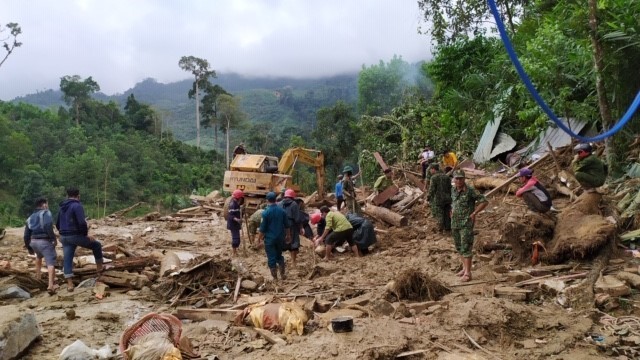 Politics & Law
Politics & Law


|
| Search and rescue personnel on October 30 looking for missing victims in a landslide that claimed eight lives and resulted in eight others missing in the mountainous district of Trà Leng, Quảng Nam Province in central region, following heavy rainfall due to the ninth storm of the year. — VNA/VNS Photo Trần Lê Lâm |
HÀ NỘI — Forest protection issues were in the spotlight on Tuesday in the National Assembly, amid public concern that the loss of forests had contributed to the devastation from floods and landslides in the central region in recent weeks.
Nguyễn Lân Hiếu, a deputy from An Giang Province, who just returned from the central region in a trip to provide aid and support for those affected by the floods, said the havoc was the “consequence of our assault on Mother Earth, assault on the mountains, the rivers, the forestlands which have embraced and supported human lives for thousands of years.”
The cutting down of forests, the blocking of river flow and the digging up of mountains were to blame for erratic climate events, Hiếu said.
“We called for the growth of forests but still allowed major projects to be constructed right within the core area of natural forests, or a spatter of small-scale hydropower plants to still be operational or newly licenced, which just means the suffering and historic new records of devastation will continue,” Hiếu said.
He called for a change in mindset, citing the example of many people’s perception that natural wood is somehow more beautiful than industrially grown wood and furniture made from rare trees is favoured.
Nguyễn Thanh Hải, from Tiền Giang Province, shared Hiếu’s concerns about small-scale hydropower as the forest loss would lead to landslides and erosion.
Phan Thái Bình from Quảng Nam Province, one of the central localities that have suffered from successive floods and strong storms since early October this year, proposed measures to protect existing forests and restore lost forest areas.
Bình said the Government should consider providing a free and sufficient supply of rice to ethnic minority people in mountainous areas so they would not have to resort to clearing forestlands to be used as rice fields.
“Our production capacity can surely take care of this,” Bình said, referring to Việt Nam’s position as one of the world's top rice producers.
Bình also called for planting native, large wood trees, especially in newly planted forests that are meant to make up for the losses of natural forestlands incurred during major projects.
The location of the newly planted forestland should also be carefully considered by authorities, especially in terms of how the new forest area could protect downstream from severe flooding – similar to protection forests in upstream that can soak up a lot of rainfall in the ground, Bình said.
He also suggested a thorough, critical assessment of all reservoirs and hydropower plants in the country to see the impacts they have on the environment and publicly publishing the findings for all people to know, alleviating their concerns over the safety of the projects.
Responding to lawmakers’ concerns, Minister of Agriculture and Rural Development Nguyễn Xuân Cường painted a rosier picture of the country's forest situation.
The country currently has 14.6 million hectares, 70.5 per cent of which, or about 10.3 million hectares, are natural forest, with the remaining planted forest.
The current forest coverage ratio of the country is about 42 per cent against the global average of 29-30 per cent.
Compared to Việt Nam’s total area of 9 million hectares and coverage rate of 27 per cent back in 1990, the current rate is a “breakthrough achievement of the entire political system and the people” in just a span of three decades given the country’s still humble economic output, according to Cường.
The Party, the State, and National Assembly have always had policies in place for local people to take care of natural forests with increasingly higher benefits.
The policy to allocate State forestlands to households and individuals so they could both exploit the resources while protecting the forestlands currently pays about VNĐ520,000 per hectare annually, Cường said, adding that the NA asked that the rate should be increased to VNĐ1 million for effective protection of the 10.3 million hectares of natural forests.
However, the agriculture minister admitted that 30 years is not enough time for natural forest areas to regenerate back to the previous level, given how 77 million litres of defoliants devasted 2 million hectares in central Việt Nam during the American War.
“It takes time for the forests to be restored,” Cường said.
He ended his response to the lawmakers by saying the world has acknowledged Việt Nam’s commitments to sustainable forest development. — VNS




